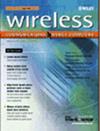基于形态学图像处理的无线电通信频谱增强信号面积估计
4区 计算机科学
Q3 Engineering
引用次数: 0
摘要
信号区域(SA)的概念,定义为频谱图中检测信号的矩形时频区域,在频谱使用测量中起着重要作用。在动态频谱接入系统中,信号区域估计(SAE)在向二级用户分配空白频谱的过程中所起的作用,以及在频谱法规的合规性验证和执行、信号拦截、网络规划和优化等其他有趣的应用中所起的作用,证明了对信号区域估计(SAE)的需求是合理的。现有的SAE方法还远远不够完善,因此需要能够提供更准确估计的新解决方案。本研究探讨了一种基于图像处理技术的新方法。具体而言,探讨了使用形态操作(MOs)的可行性,以检验其在SAE背景下的实用性。通过广泛的模拟,研究了SAE背景下不同MOs(侵蚀、膨胀、打开和关闭)在不同配置下的性能,包括不同形状和尺寸的结构元件(SE),同时作为单独的SAE方法使用,以及与文献中的其他SAE方法结合使用。基于获得的结果,基于每个特定信噪比的最佳MO和SE配置,制定了基于MO的SAE方法,当用作预处理或后处理技术时,该方法可以大大提高其他提出的SAE方法的性能。具体来说,在低信噪比下,F1分数的准确率提高了40%,而在高信噪比下,准确率达到了100%。这样做不会对相关的计算成本产生明显的影响(在高信噪比下甚至可以降低15%)。因此,在低信噪比条件下,大多数方法的性能都受到限制,因此,所提出的SAE方法可以扩展现有SAE方法的工作信噪比范围。本文章由计算机程序翻译,如有差异,请以英文原文为准。
Enhanced Signal Area Estimation in Radio-Communication Spectrograms Based on Morphological Image Processing
The concept of signal area (SA), defined as the rectangular time–frequency region in a spectrogram where a signal is detected, plays an important role in spectrum usage measurements. The need for signal area estimation (SAE) is justified by its role in the process of allocating white space spectrum to secondary users in dynamic spectrum access systems as well as in other interesting applications such as compliance verification and enforcement of spectrum regulations, signal interception, and network planning and optimisation. Existing SAE methods are far from perfect and therefore new solutions capable to provide more accurate estimations are thus required. In this study, a novel approach based on image processing techniques is explored. Concretely, the feasibility of using morphological operations (MOs) is explored to examine its usefulness in the context of SAE. By means of extensive simulations, the performance of different MOs (erosion, dilation, opening, and closing) in the context of SAE is investigated under various configurations, including different shapes and sizes of the structuring element (SE), when used both as standalone SAE methods and in combination with other SAE methods from the literature. Based on the obtained results, an MO-based SAE method is formulated based on the optimum MO and SE configuration for each specific SNR regime, which can improve substantially the performance of other proposed SAE methods when used as a pre- or postprocessing technique. Concretely, the accuracy improvement in terms of F1 score is up to 40% in the low-SNR regime while achieving a perfect accuracy of 100% in the high-SNR regime. This is achieved without having a noticeable impact on the associated computational cost (and even reducing it by up to 15% at high SNR). The performance improvement is thus particularly significant in the low-SNR regime, where most methods’ performances are limited, and as a result the proposed SAE approach can extend the operational SNR range of the existing SAE methods.
求助全文
通过发布文献求助,成功后即可免费获取论文全文。
去求助
来源期刊
自引率
0.00%
发文量
2475
审稿时长
9.9 months
期刊介绍:
Presenting comprehensive coverage of this fast moving field, Wireless Communications and Mobile Computing provides the R&D communities working in academia and the telecommunications and networking industries with a forum for sharing research and ideas.
The convergence of wireless communications and mobile computing is bringing together two areas of immense growth and innovation. This is reflected throughout the journal by strongly focusing on new trends, developments, emerging technologies and new industrial standards.

 求助内容:
求助内容: 应助结果提醒方式:
应助结果提醒方式:


